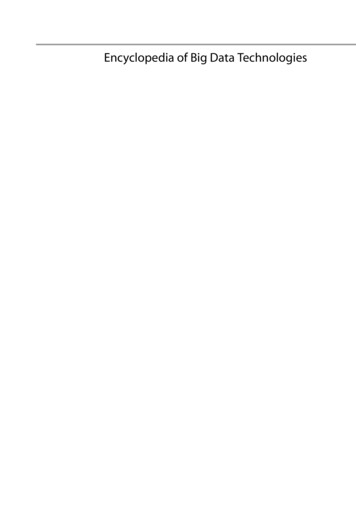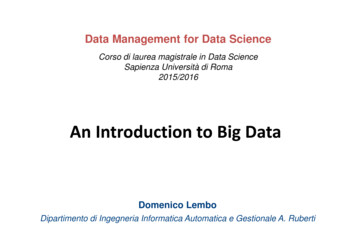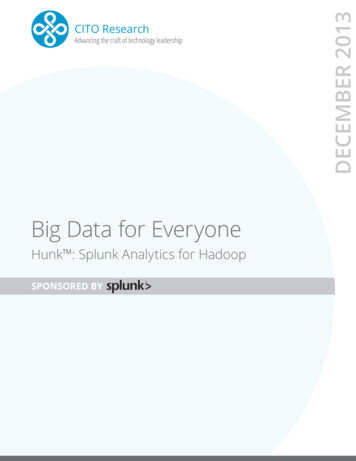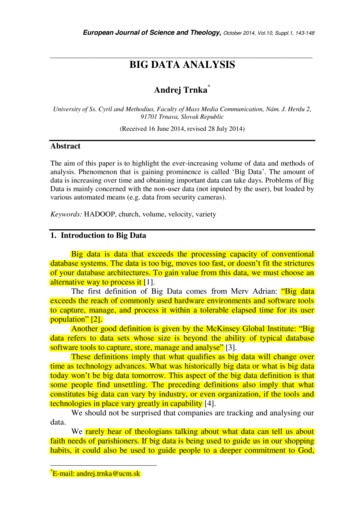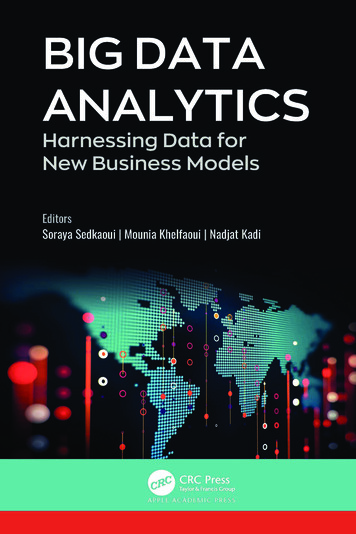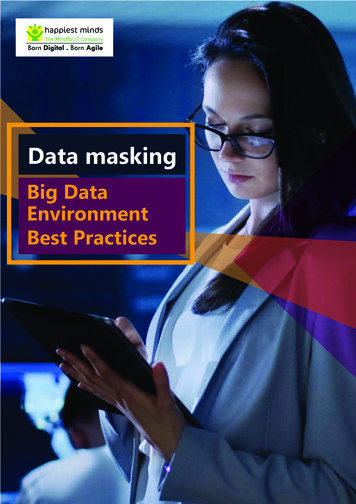
Transcription
Data maskingBig DataEnvironmentBest Practices
IntroductionMany organizations accidentally breach the Data Protectionwhile moving sensitive information from Production tonon-production environments, this puts customers’ confidential information at stake and the possibility of data privacy breach is high when the data goes to the hands of inappropriate stakeholder. However, the necessity of productiondata is high since developers, and analytic researchers relyon the factual data for their strategy, research, and development. Moving the sensitive information from production toother environments will lead to noncompliance of data regulations like GDPR, PCI DSS, HIPAA, and so on. Therefore,there is a need for a tool that can remediate this gap andenables smooth transfer of information to the lower environment without revealing the sensitive information alsocomply with Data regulations.
Big DataBig Data is a collection of large data sets with Structured,Semi-structured and unstructured data types that can beanalyzed computationally to reveal patterns and trendsfrom the stored data. Recently many organizations managing and utilizing bulk data sets such as social media,airlines, streaming, satellite, and IoT are deploying BigData platforms to store sensitive and high-velocity data.Big Data Security in Cloud ComputingSince the organizations have hugely adopted theBig data platforms, the security of these platforms, need to be tightened as it involves theusage and storage of sensitive information.Big Data Security in Cloud Computingis vital due to the following issues: To protect and prevent Large size of sensitivebusiness, defense, or regulatory information’sfrom unauthorized user access To Prevent users from copying confidentialinformation to the lower environments likeUAT for research and analytics To minimize risk while sharing the data withinthe organization or with third parties To comply with data regulation standards likeGDPR, PCI, PII, and PHI, and so on.
Best Practices to deal withBig Data Risks and DatamaskingUnderstand the DataBefore masking any datasets, it is primal tounderstand the type of data that needs to besecured. Because it is impossible to secure everypiece of data in a Big Data environment. Doingthat will utilize the entire resources and affect theother data processing in Big data cloud. Therefore, before proceeding with the data protectionsolutions, evaluate the sensitive data that needsto be moved to a lower environment or whichneeds to be shared with the research team tounderstand the pattern. Prioritize only those datafor protection, discover and identify highly sensitive information, such as personally identifiableinformation (PII), personal health information(PHI) and other intellectual property from thestored data in Big data cloud.Defining PoliciesMasking policy is essential to protect all sensitive data. As the data will be used for development, testing, backup, and analytics purposes itis mandatory to understand the available dataand what it points at. Ideal data masking technique is selected based on sensitive data present and its location. While implementing onemust consider system architecture, estimateddata sizing, and business needs.
Data Masking Vs EncryptionThere are some similarities between datamasking and encryption, but in operational,both serve a different purpose. Data maskingis one-way process once the data is masked itcannot be de-masked but in the case ofEncryption techniques such as FPE (FormatPreserved Encryption) the data can beencrypted and decrypted using the encryptionkeys. Therefore, the selection of techniquesrelies on the use case. Encryption helps protecting data from external attacks and datamasking is for safeguarding sensitive datainternally.Data integrityAfter the masking process is complete,ensure that the data integrity is maintained.Quality assurance and testing are performedto ensure masking configurations are producing the intended results.Review the Masking Performanceand MaintenanceIt is paramount to assess masking performance and bring in necessary changes inmasking configuration to optimize performance by fine-tuning the policies, sizing ofthe data and adopted masking techniques.Review reports and systems logs enableeffective and efficient maintenance. Knowledge transfer, user training, and handoffensure proper understanding of the selectedmasking process. Maintaining proceduredocuments and active change managementacts as a knowledge base.
ConclusionAll organizations should ensure reliable protection for sensitive data to meet compliance requirements and prevent a data breach. Data breaches and loss of data can have a negative impact onthe business, including legal and financial losses. Discovering sensitive data and administeringappropriate masking and encryption techniques help organizations to meet regulatory requirements and customers’ call to protect raw data.About Happiest Minds TechnologiesHappiest Minds, the Mindful IT Company, applies agile methodologies to enable digital transformationfor enterprises and technology providers by delivering seamless customer experience, businessefficiency and actionable insights. We leverage a spectrum of disruptive technologies such as: Big DataAnalytics, AI & Cognitive Computing, Internet of Things, Cloud, Security, SDN-NFV, RPA, Blockchain,etc. Positioned as “Born Digital . Born Agile”, our capabilities spans across product engineering, digitalbusiness solutions, infrastructure management and security services. We deliver these services acrossindustry sectors such as retail, consumer packaged goods, edutech, e-commerce, banking, insurance,hi-tech, engineering R&D, manufacturing, automotive and travel/transportation/hospitality.Headquartered in Bangalore, India Happiest Minds has operations in USA, UK, The Netherlands,Australia and Middle East.About AuthorSathish Kumar works with Happiest Minds Technologies as TechnicalLead – Data Security Practice. He has an overall experience of 8.3years in Data Security and Cyber Security. He has extensive experience in implementing various Data Security products in the Big Dataenvironments, Databases, Exchange, Fileservers and so on.To know more about our offerings. Please write to us at business@happiestminds.comcopyright @ happiestminds technologies
Best Practices to deal with Big Data Risks and Data masking Understand the Data Before masking any datasets, it is primal to understand the type of data that needs to be secured. Because it is impossible to secure every piece of data in a Big Data environment. Doing that will utilize the entire resources and affect the

